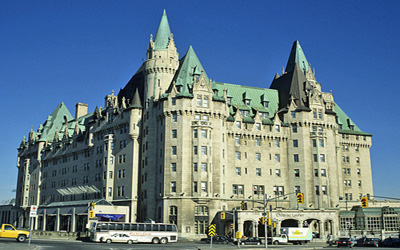Château Laurier National Historic Site of Canada
Ottawa, Ontario

General view
© Parks Canada Agency / Agence Parcs Canada.
Address :
1 Rideau Street, Ottawa, Ontario
Recognition Statute:
Historic Sites and Monuments Act (R.S.C., 1985, c. H-4)
Designation Date:
1981-01-15
Dates:
-
1908 to 1912
(Construction)
-
1920 to 1920
(Significant)
Event, Person, Organization:
-
Grand Trunk Pacific Railway Company
(Organization)
-
Machine Gun Corps
(Organization)
-
Bradford Lee Gilbert
(Architect)
-
Ross and MacFarlane
(Architect)
Other Name(s):
-
Château Laurier
(Designation Name)
Research Report Number:
1980-021
Plaque(s)
Existing plaque: 1 Rideau Street, Ottawa, Ontario
Designed by the architectural firm of Ross and MacFarlane this hotel was built between 1908 and 1912 and enlarged in the 1920s. It was the first in a chain of Château style hotels constructed by the Grand Trunk Railway (later incorporated into the Canadian National Railways), to encourage tourists to travel its routes. Distinguished by its crisp facades and steep, copper roofs, the hotel's picturesque appearance captures the romance of travelling by train. The Châteauesque rooflines of several federal government buildings in Ottawa were inspired by the commanding presence of this hotel.
Description of Historic Place
The Château Laurier National Historic Site of Canada is an early-20th-century hotel located across from the Former Union Railway station in downtown Ottawa, Ontario. It sits atop the banks of the Ottawa River, overlooking both the river and the Rideau Canal. This picturesque hotel, constructed in the Château style is a commanding presence in Confederation Square, a national historic site of Canada encompassing some of the most recognizable historic buildings in the downtown core of the capital. Official recognition consists of the hotel building on the legal property on which it sat at the time of recognition.
Heritage Value
The Château Laurier was designated a national historic site of Canada in 1980 because: it is a Château-style hotel, which is of national significance as an architectural type.
The Château Laurier, built between 1908 and 1912, was the first in a series of hotels constructed by the Grand Trunk Pacific Railway Company (GTPR) to encourage tourists to travel its transcontinental routes. From Québec to Victoria, these Château-style hotels can be found near the railway stations in their urban environment, often in a dramatic location. The Château-style vocabulary used by the railway hotels evolved as a distinctly Canadian architectural type, and came to symbolize fine hotel accommodation. When the Château style began to evolve into a distinctly ‘national’ style of architecture, the physical proximity of the Château Laurier to the seat of the federal government led the hotel to serve as a model for the style. The constant reinforcement of this architectural image across the country provided a powerful visual expression of the bond that links these cities and regions of diverse cultural and geographic characters into a national unity.
The Montréal architectural firm Ross and MacFarlane designed the Château Laurier, and based their plans on designs created by New York’s Bradford Lee Gilbert. The pale Indiana limestone walls of the Château Laurier harmonized with the nearby Grand Trunk railway station, and the steep roof, turrets, and gothic details of the structure ideally suited the character and climate of Canada. From 1916 to as late as the 1950s, the federal government insisted that all federal architecture in Ottawa conform in some way to this style. This is demonstrated in buildings such as the Confederation Building and the roof structure of the Supreme Court Building.
Sources: Historic Sites and Monuments Board of Canada, Minutes, June 1980, January 1981.
Character-Defining Elements
Key elements that contribute to the heritage character of the site include: its romantic setting atop the banks of the Ottawa River and overlooking the Rideau Canal; its proximity to Parliament Hill and to other federal government buildings in the Ottawa downtown core; its irregular L-shaped plan; its elements which typify Château-style railway hotels, including its massive scale, irregular silhouette, steeply-pitched copper roofs, ornate gables and dormers, towers and turrets, high-quality materials, and dramatic setting; the smooth finish and pale tone of the exterior Indiana limestone walls, contrasting sharply with the ornate detailing above the eave-line; its symmetrical front façade, defined by two octagonal pavilions, vertically accented by a strip of oriel windows; its picturesque silhouette, created by a broad range of medieval detail, including turrets, machicolations, and finialed and crocketed gables; its whimsical and delicate corner tower, inset deep into the wall; its arcaded entrance loggia; its close physical relationship with the former Ottawa Union Station, also constructed using pale, Indiana limestone, and its proximity and relationship with the Confederation square National Historic Site of Canada and its affiliated buildings of national historic import.